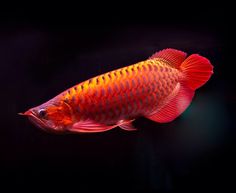UNAIR NEWS- Arowana fish is often considered the king of ornamental fish. In addition to its beautiful body color, Arowana fish have a very high price and are rare to find. Various species of arowana fish are scattered globally, but the most in-demand species are mostly from Southeast Asia.
Indonesia has quite a variety of Arowana species, the gulf saratoga (Scleropages jardini); southern saratoga (Scleropages leichardti); super red arowana, banjar red arowana, red tail golden arowana, and asian arowana (Scleropages formosus).
According to Rendy Ginanjar S. Pi, M.Sc, as the Head of the Arowana fish management team from the Research Institute for Ornamental Fish Cultivation (BRBIH), the super red arowana is one of the research focuses of BRBIH. He conveyed this at a webinar titled ‘Arwana Talk’ initiated by the Faculty of Fisheries and Marine Sciences (FPK) UNAIR and BRBIH Depok on August 9, 2021. They focus on them because of their high price. Furthermore, the fish has an amazing appearance and is quite aggressive, becoming an important ornamental fish commodity.
According to the official website of kkp.go.id, in 2018, 4,058 super red arowana fish were sold, with a total price of more than 10 billion Rupiah. In 2019, 2,360 were sold with a total price of 2.5 billion Rupiah. However, this fish has become ‘threatened’ due to fishing, land changes, and environmental degradation.
Rendy also explained the Chinese ethnic mythology regarding super red arowana fish. When you take care of this fish properly, it is believed to bring good luck and prosperity to the owner.
“Therefore, this fish is easy to sell in a country with many Chinese communities, and especially in China,” explained Rendy.
Arowana fish cultivation is quite difficult and takes a long time. Sexual or genitals maturation from the shape of an egg to adult takes 2-4 years. The eggs produced are not many, ranging from 20 to 90 eggs. The egg incubation time is also quite long, in the range of 50 days. Furthermore, another obstacle is the difficulty of identifying males and females.

Darmawan Setia Budi S.Pi., M.Si, an FPK UNAIR lecturer, explained that the natural spawning of arowana fish only occurs in July and November. However, it can also be done off-season with adequate nutrition. He also explained that the incubation time of eggs can be accelerated by placing the eggs in an incubator so that the parent can carry out the next reproductive process.
“So that it can overcome the limited number of parents, and the next reproductive process can run early,” explained Darmawan at the ‘Arwana Talk’ event on August 9, 2021.
Darmawan also introduced production engineering technology that can be done on Arowana fish. The technology is germ cell transplantation which is used to obtain a host or surrogate mother. For example, a substitute parent can be used in super red arowana fish that often experience reproductive problems.
“So, a tissue is taken from a super red arowana fish and inserted (for example) into a silver arowana and later the silver arowana will lay super red arowana fish eggs,” concluded Darmawan.
Author: Muhammad Ichwan Firmansyah
Editor: Feri fenoria (AC/AP)





